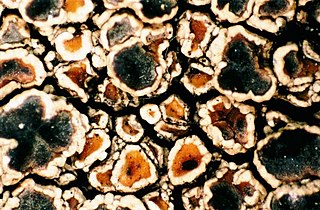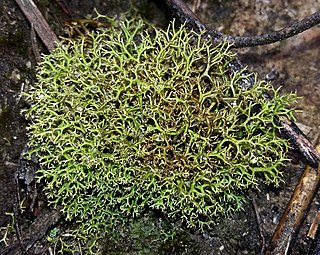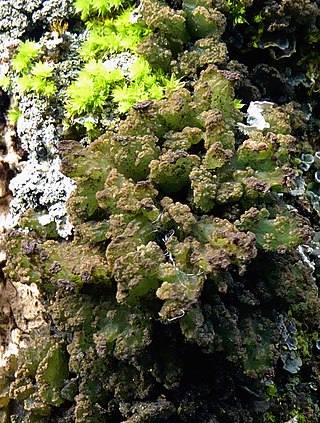
The Cladoniaceae are a family of lichenized fungi in the order Lecanorales. It is one of the largest families of lichen-forming fungi, with about 560 species distributed amongst 17 genera. The reindeer moss and cup lichens (Cladonia) belong to this family. The latter genus, which comprises about 500 species, forms a major part of the diet of large mammals in taiga and tundra ecosystems. Many Cladoniaceae lichens grow on soil, but other can use decaying wood, tree trunks, and, in a few instances, rocks as their substrate. They grow in places with high humidity, and cannot tolerate aridity.

Megasporaceae are a family of fungi belonging to the order Pertusariales. Taxa are lichenized with green algae, and grow on rocks, often in maritime climates close to fresh water. Phylogenetic analysis has shown that this family is related to the Pertusariaceae, another family of lichens. The genus Aspicilia was moved here from the Hymeneliaceae.

The Acarosporaceae are a family of fungi in the order Acarosporales. Members of this family have a widespread distribution, and are mostly lichenized with green algae. According to a 2021 estimate, the family contains 11 genera and about 260 species. The family is characterised by a hamathecium formed of paraphysoids.
Squamella is a genus of lichenized fungi in the family Cladoniaceae. The genus is monotypic, containing the single species Squamella spumosa, which is found in Australia. Both the genus and species were described by Samuel Hammer in 2001.
Sphaerophoropsis is a genus of lichenized fungi in the family Cladoniaceae. A monotypic genus, Sphaerophoropsis contains the single species Sphaerophoropsis stereocauloides. Both the genus and species were described as new to science in 1890 by Finnish lichenologist Edvard August Vainio, from collections made in Brazil.
Notocladonia is a genus of two Australasian species of lichenized fungi in the family Cladoniaceae. The genus was circumscribed by lichenologist Samuel Hammer in 2003. The type species, Notocladonia cochleata, was previously placed in the genus Ramalea.
Metus is a genus of three species of lichenized fungi in the family Cladoniaceae. The genus was circumscribed by lichenologists David John Galloway and Peter Wilfred James in 1987, with Metus conglomeratus as the type species. All three species are found in the Southern Hemisphere.

Cladia is a genus of lichenized fungi in the family Cladoniaceae. Cladia species have a crustose primary thallus and a fruticose, secondary thallus, often referred to as pseudopodetium. The type species of the genus, Cladia aggregata, is widely distributed, occurring from South America, South Africa, Australasia and South-East Asia to southern Japan and India. Most of the other species are found in the Southern Hemisphere.

Cetradonia is a lichen genus in the family Cladoniaceae. A monotypic genus, Cetradonia contains the single species Cetradonia linearis. The genus was circumscribed in 2002 by Jiang-Chun Wei and Teuvo Ahti. The genus was once placed in the family Cetradoniaceae until that family was subsumed into the Cladoniaceae in 2006.
Calathaspis is a lichen genus in the family Cladoniaceae. A monotypic genus, Calathapsis contains the single species Calathaspis devexa, which is found in Papua New Guinea in middle- and high-altitude forests at altitudes ranging from 2,000–4,000 metres (6,600–13,100 ft). The genus name, which combines the Greek κάλαθος and κάλαθος ("shield"), refers to the shape of the apothecia. The species epithet devexa, from the Latin devexus, refers to the arrangement of the thalline laciniae.

Anaptychia is a genus of lichen-forming fungi in the family Physciaceae.

The Arctomiaceae are a family of lichenized fungi in the Ascomycota, class Baeomycetales. The family was named by Theodor Magnus Fries in 1861, with Arctomia as the type genus. Species in this family are found in arctic and subarctic habitats, usually associated with bryophytes.
Coelopogon is a genus of lichen-forming fungi in the family Parmeliaceae. The genus contains two species found in southern South America and South Africa.

Edvard August Vainio was a Finnish lichenologist. His early works on the lichens of Lapland, his three-volume monograph on the lichen genus Cladonia, and, in particular, his study of the classification and form and structure of lichens in Brazil, made Vainio renowned internationally in the field of lichenology.
Cladonia wainioi or the Wainio's cup lichen is a species of cup lichen found in boreal and arctic regions of the Russian Far East and northern North America.

Cladonia sobolescens, commonly known as the peg lichen, is a species of fruticose lichen. It is found in temperate eastern North America and East Asia.

Cladonia subradiata is a widely distributed species of fruticose lichen in the family Cladoniaceae. It is found in Asia, Africa, Melanesia, Australia, New Zealand, and South, Central, and North America.

Cladonia transcendens or the graduated cup lichen is a species of fruticose, cup lichen in the family Cladoniaceae.
Rexiella is a lichen genus in the family Cladoniaceae. The genus, originally circumscribed with the name Rexia by authors Soili Stenroos, Raquel Pino-Bodas, and Teuvo Ahti in 2018, was created to contain the species Cladonia sullivanii, first formally described in 1882 by Swiss botanist Johannes Müller Argoviensis. After publication of the new genus, it was discovered that the name was illegitimate, because an earlier homonym had been published; the generic name RexiaD.A.Casamatta, S.R.Gomez & J.R.Johansen had already been created in 2006 to contain the cyanobacterial species Rexia erecta. The new name Rexiella was therefore proposed in 2019. This name honours the Australian lichenologist Rex Filson, who published monographs on the genera Cladia and Heterodea.

Pulchrocladia is a genus of fruticose lichens in the family Cladoniaceae. It has three species. The genus was circumscribed in 2018 by lichenologists Soili Stenroos, Raquel Pino-Bodas, Helge Thorsten Lumbsch, and Teuvo Ahti. The genus name refers to "the beautiful morphology of its species".











